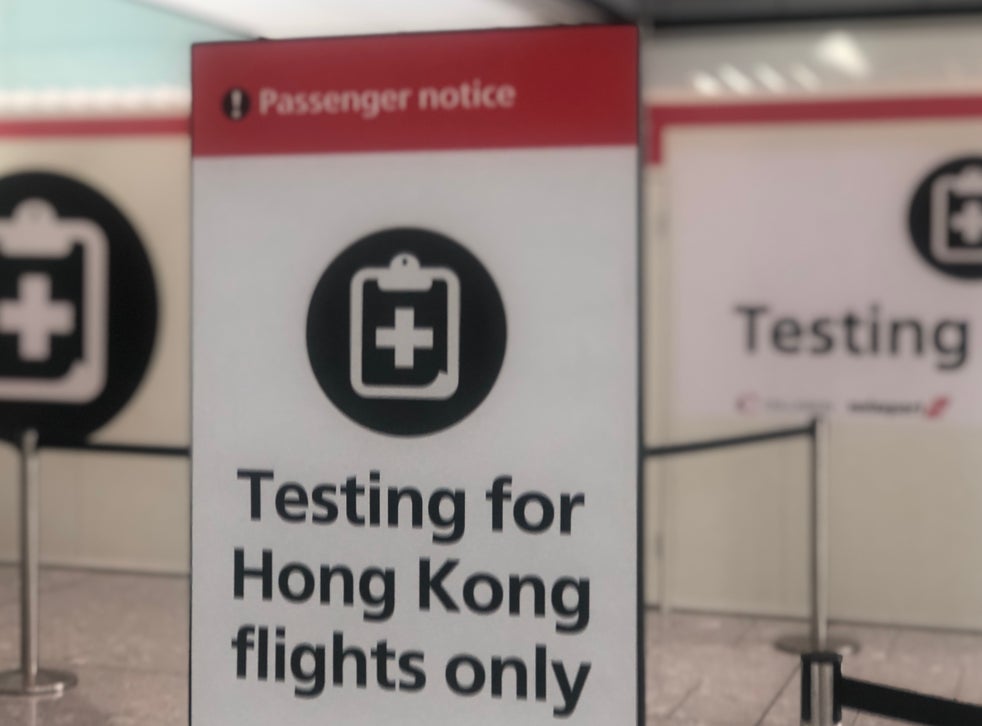Few passengers make it as far as the southern extreme of the arrival level at Heathrow Terminal 5. But anyone venturing beyond the traditional meeters’ and greeters’ base camp of Caffe Nero will see a new installation where part of the future of travel might just be taking shape.
“Open wide and say ‘aaah’ for as long as you can,” instructs David, the nurse.
“I’ve got five touch points at the back of the throat that I need to get, so if you continuously say ‘aaah’ it makes life easier to get to those points.”
Anyone who has undergone a PCR test for coronavirus will know the feeling, but this procedure is different in two ways.
First: the swabbing of the back of my throat, swiftly followed by a gentle exploration of my left nostril, is not taking place in an Ikea car park. Instead I am inside a smart white “pop-up” clinic at what is normally the busiest terminal in Europe’s busiest airport.
Second: this is a different test, known as LAMP. I can confirm that the user experience is pretty much the same as a PCR test, the “gold standard” as used by the NHS. Both tests seek evidence that the virus is currently in your body, as indicated by the presence of RNA genetic material in the virus. But what happens to the deftly quarried sample is very different.
PCR tests are taken in batches to remote laboratories for processing, which involves some gentle cooking to stimulate reproduction of any RNA. But a LAMP test can be analysed at ambient temperature adjacent to the testing centre, with the result known in an hour or less.
For the traveller and the travel industry, both of those distinctions could be crucial. An internationally agreed system for releasing aviation from the stranglehold of government restrictions and passenger uncertainty may well depend on the existence of high-efficiency test centres devoted to the needs of airlines, their staff and their passengers.
Easing the process of travel will also depend on mutual acceptance by individual governments of biosecurity protocols.
“I’m not sure we’ll ever get to a single agreed standard,” says Scott Sunderman, managing director of Medical and Security Assistance at Collinson — the firm that has organised the testing centre in association with the ground handler Swissport and Heathrow itself.
“But what I think we’ll get to is a framework which will allow the traveller to look on their device. It will tell them exactly what’s required for the location they’re going into, what sort of test they need and what sort of timeframe they need to take the test in.
“That person can then go to a lab, or come to a facility like this one here, do the test, the test results will be uploaded to their device, and then they can travel.”
But where can they travel to, exactly? At present, the Heathrow facilities — in Terminal 2 as well as Terminal 5 — are available only for people heading for Hong Kong and, soon, Tokyo.
The £80 test would be ideal for Cyprus-bound passengers, all of whom require proof of a negative Covid-19 result before boarding their planes to the Mediterranean island.
Currently, holidaymakers have to find a private test somewhere near their home, and typically pay £150 for the privilege. But Larnaca-bound passengers cannot be checked out for Covid before they check in their bags at Heathrow.
The Cypriot health ministry requires each traveller “to possess a certificate showing negative PCR examination for the virus”.
Governments believe they know what works, and many have yet to be convinced that LAMP tests are as reliable.
Mr Sunderman says the evidence is mounting that the two tests are equally effective. And he also recognises the irony that the nation’s sole coronavirus testing facility aimed specifically at travellers is actually working on behalf of foreign governments — to minimise harm at the destination, rather than the UK.
Collinson was ready, willing and able to test passengers touching down at Heathrow as early as July. But the government has been scathing about the value of testing on arrival, known as “day zero”.
Grant Shapps, the transport secretary, last week spelt out to the online convention of Abta, the travel association, why he regards arrival testing as pointless.
“We know for certain that if you were to test people on day zero, that isn’t going to help,” he said.
“You’d only pick up about 7 per cent of those who are asymptomatic coming off that flight on day zero.”
Yet Mr Shapps also talked of a pilot programme involving the UK, US and Singapore involving tests before departure, and even suggested quarantine could be ditched for passengers who undergo a specified testing regime.
Meanwhile Collinson’s health supremo is pleasantly surprised by the take-up of tests by both flight crew and passengers.
“It’s momentum in the right direction,” he says.
Given that global aviation enabled coronavirus to take hold so swiftly, many people have deplored the continuation of international aviation. They may see initiatives such as the pop-up testing centre not as a solution but as part of the problem.
“How to spread the virus and not give a flying f*** about people dying,” tweeted one viewer of Good Morning Britain after an item about the Heathrow tests.
“The reality is this virus is here for some time, and we’re going to have to learn to live with it,” says Scott Sunderman.
“We’re going to have to learn to continue to conduct economic activity whilst it’s here. We’re figuring out ways, like we’re doing here, to do it safely with the virus in the background.”

